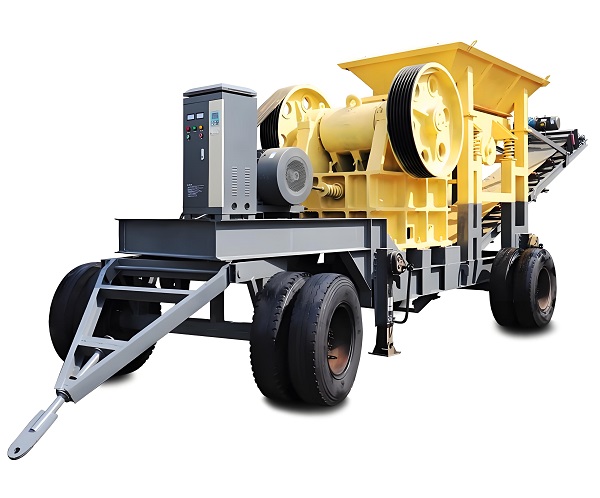
Mobile jaw crusher is an intelligent mining equipment that integrates crushing, screening and conveying. It can realize flexible transfer operation through the movable chassis design. It has the characteristics of large crushing ratio, high processing efficiency and low energy consumption. It is widely used in mining, construction aggregate production and other fields. The advantages of strong mobility, small footprint and convenient transfer significantly reduce the infrastructure cost, which is especially suitable for small and medium-sized projects and operations in complex terrain.
Mobile jaw crusher is a mobile crushing equipment that integrates crushing, screening and conveying functions. It is mainly used in mining, construction aggregate production, construction waste treatment and other fields. Its core component is the jaw crusher, which generates extrusion crushing force through the relative movement of the movable jaw plate and the fixed jaw plate to process large blocks of materials (such as granite, limestone, concrete blocks, etc.) into aggregates of the required particle size.
The equipment adopts a modular design, integrating feeder, crusher, vibrating screen and conveyor belt. It can be flexibly moved through tires or crawler chassis without fixed installation, which significantly shortens the on-site deployment cycle. Its crushing chamber is deep and has no dead zone, and the crushing ratio is large (up to 1:15). The processing capacity ranges from 50 tons to 500 tons per hour, which is suitable for coarse and medium crushing operations. Equipped with an intelligent control system, it can monitor the operating status of the equipment in real time and automatically adjust parameters to optimize production efficiency.
The advantages of mobile jaw crusher are high efficiency, energy saving and strong adaptability. It is especially suitable for projects in remote areas or multiple operation points, which can reduce material transportation costs. It is widely used in infrastructure projects, quarries, concrete recycling and other scenarios, effectively solving the problems of poor mobility and difficult transfer of traditional fixed crushing equipment. When using it, it is necessary to pay attention to regular maintenance of the jaw plate wear and reasonably configure the screening system to ensure that the output particle size meets the requirements.
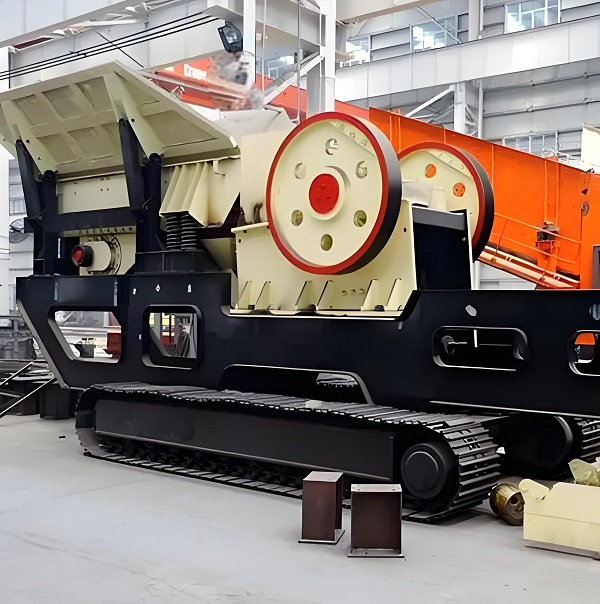
1. Production capacity matching: Accurately select the model of mobile jaw crusher according to its own production scale and expected output. Clarify the expected crushing output per hour, and then compare the rated production capacity of different models of equipment to ensure that the selected equipment can meet daily production needs and maintain stable operation during peak hours to avoid insufficient or excessive production capacity, resulting in waste of resources or low production efficiency.
2. Material adaptability: Pay attention to the adaptability of the equipment to the processed materials. Different materials have different characteristics such as hardness, humidity, and viscosity. For example, if you are dealing with high-hardness ores, you need to choose a mobile jaw crusher with wear-resistant and high compressive strength in the crushing chamber; if the material humidity is high, consider whether the equipment has a design to prevent clogging, such as a special discharge port structure or vibration device, to ensure that the equipment can efficiently and stably process specific materials.
3. Reliable equipment quality: Carefully check the manufacturing process and materials used for the equipment. High-quality mobile jaw crushers usually use advanced welding technology, with a stable body structure that can withstand high-intensity operations; key components, such as jaw plates and movable jaws, are made of highly wear-resistant materials to extend the service life of the equipment and reduce the frequency and cost of later replacement of components. The quality of the equipment can be evaluated by checking the product manual, consulting the manufacturer, or referring to the feedback from other users.
4. Consideration of mobility: Since the advantage of mobile jaw crushers is flexible mobile operation, its mobility should be examined. Wheeled mobile jaw crushers have a faster movement speed and are suitable for transfer operations on flat sites; crawler mobile jaw crushers have better off-road performance and can move freely in rugged terrain or complex construction sites. According to the terrain conditions of the actual work site, choose equipment types that are easy to move and efficient in transfer to improve overall work efficiency.
5. Perfect after-sales service: Perfect after-sales service is a strong guarantee for the long-term and stable operation of equipment. When choosing a manufacturer, it is necessary to understand whether it provides installation and commissioning services to ensure that the equipment can be correctly installed and operate normally before it is put into use; whether it has a professional technical team that can respond to equipment failure maintenance needs in a timely manner; and whether it provides a supply of wearing parts to ensure that accessories can be quickly replaced when there is a problem with the equipment to reduce downtime.
6. Price-performance ratio trade-off: Price is an important factor in purchasing, but it cannot be determined solely by price. Too low a price may mean that there are defects in the quality, performance or after-sales service of the equipment. You should compare the quotations of different manufacturers on the basis of comprehensive consideration of factors such as equipment performance, quality, and after-sales service, and choose products with high cost performance. That is, spend a reasonable price to buy a mobile jaw crusher that can meet production needs, has reliable quality and guaranteed after-sales service.
The mobile jaw crusher uses high manganese steel jaw plate and optimized cavity shape to achieve efficient crushing, wear resistance and impact resistance; the fully hydraulic drive chassis has both high maneuverability and terrain adaptability; the modular design supports fast disassembly and assembly, improving operation and maintenance efficiency; the intelligent control system accurately controls to ensure stable operation; the environmental protection configuration meets strict standards; key components are made of high-strength alloys, which significantly reduces maintenance costs and ensures long-term reliable operation.
Mobile jaw crusher supports highly customized design and can be flexibly configured according to working conditions: 1. The modular structure allows for free combination of crushing chamber types (coarse crushing/medium crushing/fine crushing) to adapt to different material characteristics; 2. The discharging particle size adjustment range is 10-150mm to meet the requirements of diversified finished products; 3. Optional diesel/electric dual power system to adapt to remote construction sites or power-limited scenarios; 4. Screening systems, conveyors and other additional equipment can be installed as needed to form a complete production line; 5. The control system supports personalized settings such as interface language and parameter thresholds to achieve human-computer interaction optimization. Flexible customization significantly improves the adaptability of the equipment to complex working conditions and maximizes resource utilization.
The mobile jaw crusher uses high manganese steel jaw plate and optimized cavity shape to achieve efficient crushing, with a maximum feed particle size of 600mm, a crushing ratio of up to 1:15, and a processing capacity of up to 300t/h. The fully hydraulic drive system provides strong power and reduces energy consumption by more than 20%. The intelligent control system supports real-time parameter control to ensure discharge accuracy and production stability. The crawler/tire double chassis design adapts to complex working conditions and is equipped with an efficient dust removal and noise reduction device to achieve the comprehensive performance advantages of high production, low consumption, and environmental protection to meet the needs of large-scale aggregate production.
The mobile jaw crusher integrates efficient crushing and intelligent control. The fully hydraulically driven chassis has dual-mode rapid transition to adapt to complex terrains. The high manganese steel jaw plate is matched with an optimized cavity shape, and the intelligent control system realizes real-time parameter adjustment and remote monitoring. The modular design supports multi-cavity switching, and the discharging particle size is adjustable. It is equipped with dust removal and noise reduction devices as standard to reduce energy consumption. The optional dual power and screening systems can meet diversified production needs. It has both high production, environmental protection and flexible adaptability.
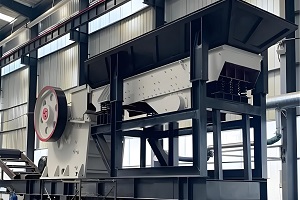
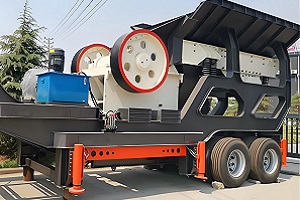
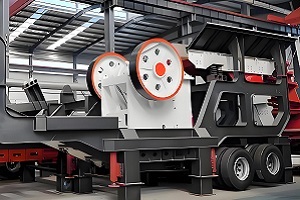
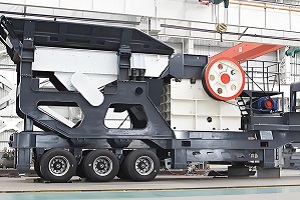
Mobile jaw crusher is mainly composed of feeder, jaw crusher, belt conveyor, etc. Its working principle is as follows:
1. Feeding stage: The material is fed into the feed port of the jaw crusher evenly and continuously by the feeder. The feeder can adjust the feeding speed according to the processing capacity of the crusher and the characteristics of the material to ensure a stable supply of materials.
2. Crushing stage: The material entering the crusher is subjected to extrusion, bending and splitting forces between the movable jaw and the fixed jaw. The movable jaw is driven by the eccentric shaft to make periodic reciprocating motion. When the movable jaw approaches the fixed jaw, the material is squeezed and crushed; when the movable jaw leaves the fixed jaw, the material that has been crushed to a size smaller than the discharge port is discharged from the discharge port, while the larger material remains in the crushing chamber and continues to be crushed until it can be discharged from the discharge port.
3. Conveying stage: The material crushed by the jaw crusher is conveyed to the next process or designated location by the belt conveyor. The conveying speed and conveying capacity of the belt conveyor can be adjusted according to production needs.

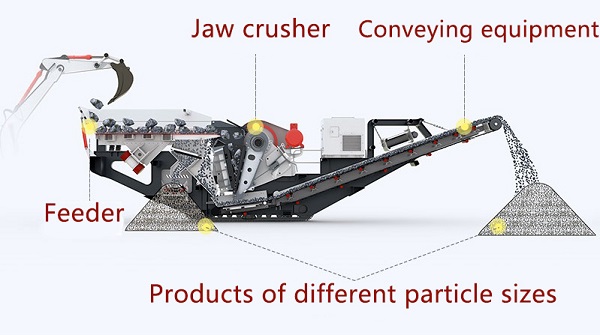
| Model | PE400×600 | PE500×750 | PE600×900 | PE750×1060 | PE900×1200 |
|---|---|---|---|---|---|
| Feed hopper volume | 5m³ | 7m³ | 11m³ | 12m³ | 20m³ |
| Feed hopper width (mm) | 2700 | 3100 | 3350 | 3430 | 3800 |
| Grizzle Feeder Model | B13 - 44 - 2V | B13 - 44 - 2V | B13 - 50 - 3V | B16 - 50 - 3V | B20 - 66 - 2V |
| Grizzle Feeder Width (mm) | 1300 | 1300 | 1300 | 1600 | 2000 |
| Grate feeder length (mm) | 4400 | 4400 | 5000 | 5000 | 6600 |
| Grate spacing (mm) | 80/105 | 105/130 | 105/130/150 | 130/150/200 | - |
| Jaw crusher model | PE400×600 | PE500×750 | PE600×900 | PE750×1060 | PE900×1200 |
| Feeding port (mm) | 400×600 | 500×750 | 600×900 | 750×1060 | 900×1200 |
| Discharge opening adjustment range (mm) | 40 - 100 | 50 - 100 | 65 - 180 | 80 - 180 | 95 - 225 |
| Main conveyor belt model | H12 - 13 | H14 - 11 | H14 - 11 | H14 - 11 | H18 - 13 |
| Main conveyor belt width (mm) | 1200 | 1400 | 1400 | 1400 | 1800 |
| Track Model | D7A | D7ELC | D7ELC | D8H | D9 |
| Engine Model | CAT C - 12 | CAT C - 12 | CAT C - 15 | CAT C - 16 | |
| Engine Power (kW) | 317 | 317 | 317 | 390 | 445 |
*The output will vary according to different materials, feed particle size and other factors.
Save Time! Get A Detailed Quotation Quickly.
